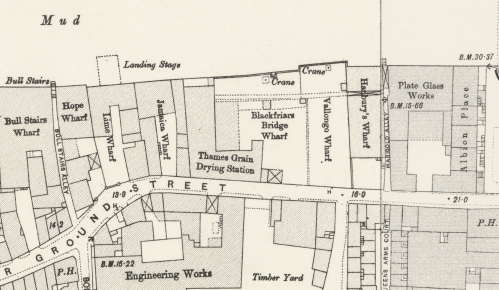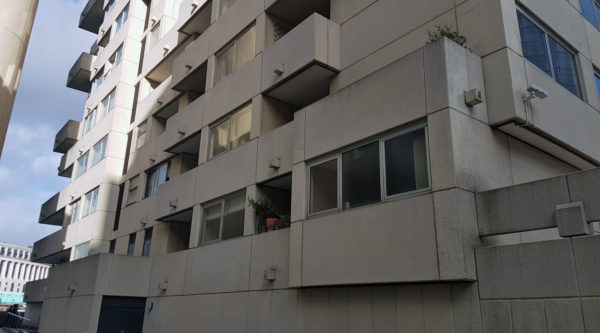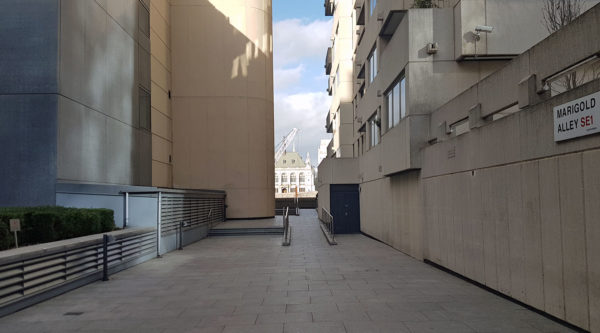This is a short modern alley that’s actually much older than it looks, and in the wrong place. Oh, and gargoyles.
Until recently, all along the riverside was cargo wharfs, and now offices and homes, and where Marigold Alley stands today was also a wharf, Blackfriars Bridge Wharf.
About 50 yards to the east was Marigold Alley, leading down to a small set of steps to the river. The name originates from the steps, not the passage. Until the 19th century, it was more common to mark the riverside by the access points, so the area was better known as Marygold Stairs.
It seems that the passage to the riverside steps squeezed in between buildings may have emerged around the 17th century when the area first started to be intensely built up, and provided to preserve public access to the river for ferrying across the Thames by the Watermen.
When the wharfs and cargos were swept away, the area was turned into a single large block of flats, and at that point, it was decided to shift the alley, which would have run through the middle to of the flats westwards to its current location. Alleys do have a tendency to shift around at times thanks to the vagaries of property developers, so this is not an unprecedented movement.
The block of flats, River Court is a distinctive block of geometrically sculptured block of flats built in 1978 by Southwark’s in-house architect, Frank Hayes.
What’s easy to overlook are the perpendicular lines of modern gargoyles, running up the building. OK, they might not be technically grotesques with spouts, but they are brutalists, with spouts, so in my books, they should be called gargoyles.
The other side of the alley is lined by the equally distinctive Sea Containers House, built as a hotel, but actually opened as offices, and in a twist of fate, the riverside of the building was converted back into a hotel in 2014. The current appearance of the alley is thanks to a lump of developer cash. When Sea Containers House was turned into a hotel, the developer was asked to supply nearly £300,000 to revamp the alley with fresh steps and slope.
Today it’s a convenient, and on my visit, well-used route from the riverside to the streets behind and the residential areas avoiding the congestion around Blackfriars bridge.











I used to work in this building but just to confuse things the part I worked was known as New Kings Beam House despite being part of Sea Containers House and I had a desk on an upper floor that overlooked the river down to Blackfriars Bridge below.
This must have been one of the poshest Civil Service office buildings given the gold lifts the building had !
A few years ago I was with a friend when we passed this building and had a meal in the hotel it has become.
I used to work in new kings beam house when it was customs and excise it was a lovely building